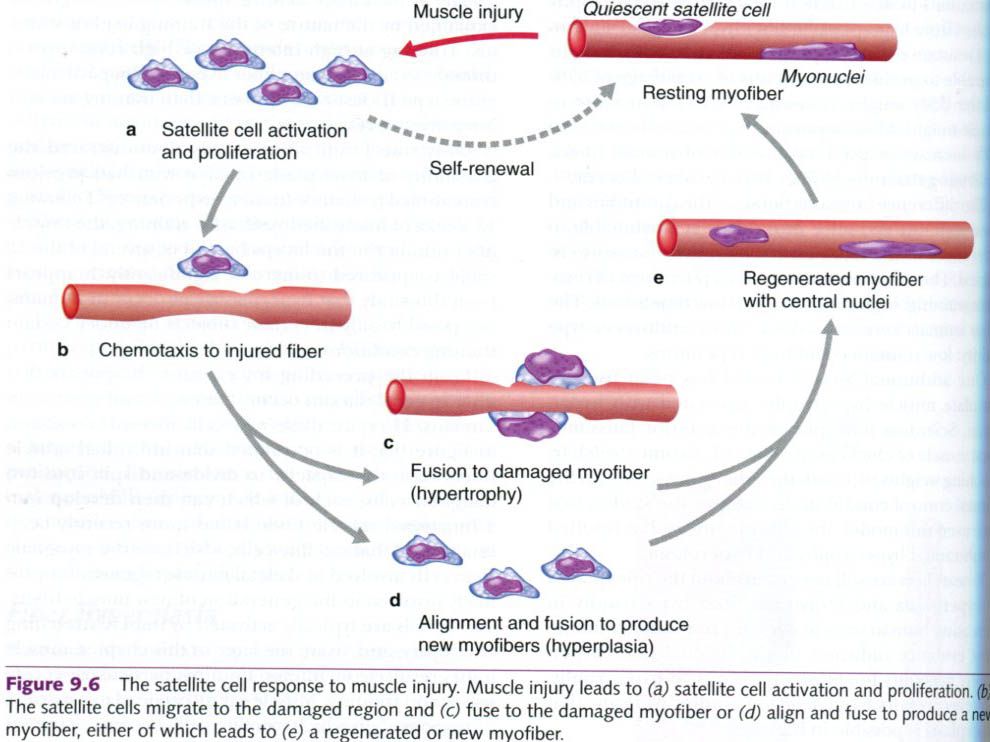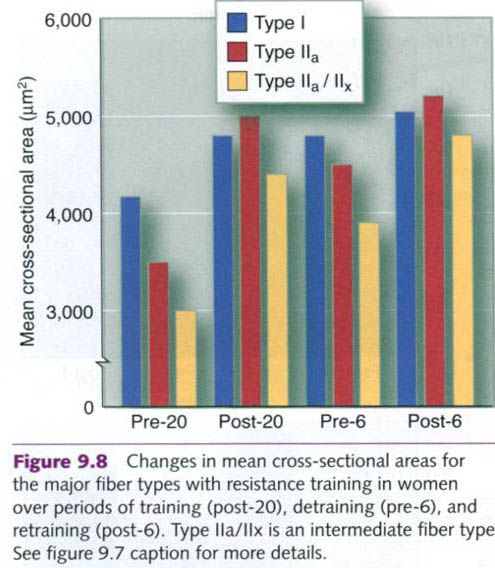Immobilization
When a trained muscle suddenly becomes inactive
through immobilization, major changes are initiated within that muscle in a
matter of hours. During the first 6h of immobilization, the rate of protein
synthesis starts to decrease. This decrease likely initiates the start of
muscular atrophy, which is the wasting away or decrease in the size of muscle
tissue. Atrophy results from lack of muscle use and the consequent loss of
muscle protein that accompanies the inactivity. Strength decreases are most
dramatic during the first week of immobilization, averaging 3% to 4% per day.
This is associated with the atrophy but also with decreased neuromuscular
activity of the immobilized muscle.
Immobilization appears to affect both type I
and type II fibers. From various studies, researchers have observed
disintegrated myofibrils, streaming Z-disks(discontinuity of Z-disks and fusion
of the myofibrils), and mitochondrial damage. When muscle atrophies, the
cross-sectional fiber area decreases. Several studies have shown the effect to
be greater in type I fibers, including a decrease in the percentage of type I
fibers, thereby increasing the percentage of type II fibers.
Muscles can and often do recover from
immobilization when activity is resumed. The recovery period is substantially
longer than the period of immobilization but shorter than the original training
period.
Cessation of training
Similarly, significant muscle alterations can
occur when people stop training. In one study, women resistance trained for 20
weeks and then stopped training for 30 to 32 weeks. Finally they retrained for
six weeks. The training program focused on the lower extremity, using a full
squat, leg press, and leg extension. Strength increases were dramatic, as seen
in the figure below. Compare the women’s strength after their initial training
period(post-20) with their strength after detraining(pre-6). This represents
the strength loss they experienced with cessation of training.
During the two training periods, increases in
strength were accompanied by increases in the cross-sectional area of all fiber
types and a decrease in the percentage of type IIx fibers. Detraining had
relatively little effect on fiber cross-sectional area, although the type II
fiber areas tended to decrease.
To prevent losses in the strength gained
through resistance training, basic maintenance programs must be established
once the desired goals for strength development have been achieved. Maintenance
programs are designed to provide sufficient stress to the muscles to maintain
existing levels of strength while allowing a reduction in intensity, duration,
or frequency of training.
In one study, men and women resistance trained
with knee extensions for either 10 or 18 weeks and then spent an additional 12
weeks with either no training or reduced training. Knee extension strength
increased 21.4% following the training period. Subjects who then stopped
training lost 68% of their strength gains during the weeks they didn’t train.
But subjects who reduced their training(from three days per week to two, or
from two to one) did not lose strength. Thus, it appears that strength can be
maintained for at least up to 12 weeks with reduced training frequency.
Fiber type alterations
Can muscle fibers change from one type to
another through resistance training? The earliest research included that
neither speed(anaerobic) nor endurance(aerobic) training could after the basic
fiber type, specifically from type I to type II, or from type II to type I.
These early studies did show, however, that fibers begin to take on certain
characteristics of the opposite fiber type if the training is of the opposite
kind(e.g. type II fibers might become more oxidative with aerobic training).
Research with animals has shown that fiber type
conversion is indeed possible under conditions of cross-innervation, in which a
type II motor unit is artificially innervated by a type I motor neuron or vice
versa. Also, chronic, low-frequency nerve stimulation transforms type II motor
units into type I motor units within a matter of weeks. Muscle fiber types in
rats have changed in response to 15 weeks of high-intensity treadmill training,
resulting in an increase in type I and type IIa fibers from type IIx to type IIa and from type IIa to type I was confirmed by several different
histochemical techniques.
Staron and coworkers found evidence of fiber
type transformation in women as a result of heavy resistance training.
Substantial increases in static strength and in the cross-sectional area of all
fiber types were noted following a 20-week heavy resistance training program
for the lower extremity. The mean percentage of type IIx fibers decreased
significantly, but the mean percentage of type IIa fibers increased. The
transition of type IIx fibers to type IIa fibers with resistance training has
been consistently reported in a number of subsequent studies. More recent
studies have shown that a combination of high-intensity resistance training
training and short-interval speed work can lead to a conversion of type I and type IIa fibers.












0 коментара:
Постави коментар